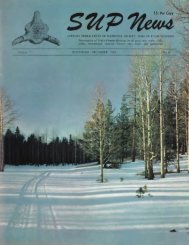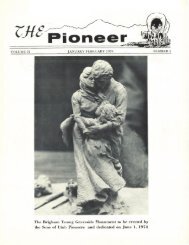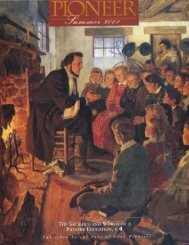Pioneer: 2011 Vol.58 No.3
Create successful ePaper yourself
Turn your PDF publications into a flip-book with our unique Google optimized e-Paper software.
the course of time East Temple was renamed Main<br />
Street, and First East became State Street. . . .<br />
Not until Brigham Young returned with the<br />
Mormon immigration of 1848 did occupation of<br />
the city plat begin; through the spring and summer<br />
the settlers carried out their farming operations<br />
from their homes in the fort.<br />
Some of the apostles had been allowed, in<br />
the summer of 1847, to select their own “inheritances,”<br />
mostly property fronting on the Temple<br />
Block, and at that time Young had picked out for<br />
himself and family the block immediately east of<br />
the Temple Square. . . . To treat land<br />
indefinitely as “inheritances” was not<br />
practical in terms of the American<br />
political and economic system; the<br />
settlers upon it could have no valid<br />
titles until the Indian title had been<br />
extinguished, formal surveys made,<br />
and the land placed upon the market<br />
by the U.S. government. These<br />
things did not come to pass for several<br />
decades, and meanwhile squatter titles<br />
developed in Utah as elsewhere.<br />
Presently Main Street began to take<br />
shape, with stores built on corners<br />
or anywhere else, on small and large<br />
plots of land, and not 20 feet back<br />
from the sidewalk. Still the 10 acre<br />
blocks remained as the basic structure<br />
of the city, and until the pressure of<br />
population forced the expansion of Salt<br />
Lake into fringe areas—first, in the late<br />
sixties and seventies, up on the sloping<br />
north benches that were carved<br />
into the small squares familiarly called<br />
the “Avenues,” and later out beyond<br />
Ninth South Street, where blocks were<br />
laid out as oblongs—this pattern did<br />
not change.<br />
First Public Building<br />
Laying out streets as straight lines<br />
crossing at right angles persisted<br />
within the memory of the living generation,<br />
and curving streets are almost<br />
solely to be found in recent subdivisions—east<br />
of Fifteenth East Street,<br />
After the lots were given out to the people,<br />
a united effort was made to fence the city.<br />
Instead of fencing each lot separately, each<br />
ward [an area of nine blocks] was fenced in<br />
one field, and each owner of a lot in a ward<br />
built his proportion of the fence. This made<br />
the work of fencing the lots comparatively<br />
easy, and it answered every purpose for several<br />
seasons. The streets were all kept open, but<br />
not at their present width. The owners of lots<br />
cultivated the streets in front of their premises,<br />
leaving no more than a sufficient space for<br />
travel. At the end of each street leading out of<br />
the ward into the main thoroughfares which<br />
ran around each ward, there were bars, which<br />
everyone who passed in or out with a team<br />
or on horseback was required to be careful in<br />
putting up. There was no monopoly of land<br />
allowed. No man was permitted to take up a<br />
city lot or farming land for purposes of speculation.<br />
Farming land was divided and given out<br />
in small parcels, so that all could have a proper<br />
proportion. . . . The enforcement of this rule<br />
made the settlement of the city and the farming<br />
lands very compact, and created a community<br />
of interest which would not have been felt<br />
under other circumstances. . . .<br />
“Next the city was surveyed into five acre<br />
lots. This was for the purpose of accommodating<br />
the mechanics and others who would<br />
reside in the city. Next to the five acre lots the<br />
ten acre lots were laid out; then the twenty<br />
acres followed by the forty and eighty acre lots,<br />
upon which farmers could build and reside.<br />
All these were, for safety and present convenience,<br />
enclosed in one common fence, each<br />
owner of land building in proportion to the<br />
amount he had in his field, and the fence to<br />
be erected in such a manner as to be satisfactory<br />
to men appointed to inspect and accept<br />
of it when completed. [In a letter of October 9,<br />
1848, Brigham Young estimated that the fence<br />
would be ‘17 miles and 53 rods long, eight<br />
feet high.’]<br />
—George Q. Cannon<br />
<strong>Pioneer</strong> <strong>2011</strong> ■<br />
volume 58 ■<br />
number<br />
3 15<br />
www<br />
■<br />
sonsofutahpioneers<br />
■<br />
org







